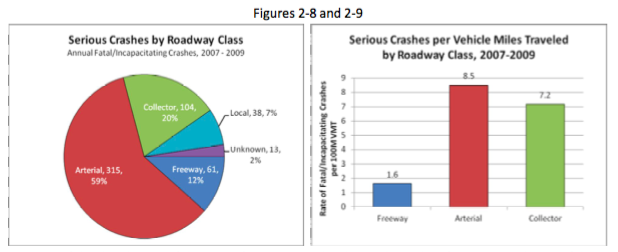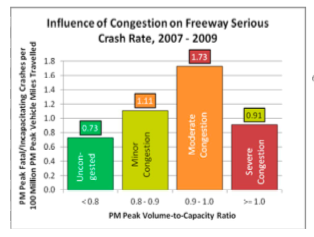Oregon’s DOT seems to be more concerned with making cars go faster than saving lives
Yesterday, we took a look at a recent Oregon Department of Transportation (ODOT) “performance report” on Portland area freeways. One of its main messages–which we found some problems with–deals with congestion. But the report also seems to devote a lot of attention to another issue: safety.
On the surface, it sounds like ODOT has gotten the memo on “Vision Zero”–the idea that we should be working to reduce traffic deaths to zero. Their new report uses the word “crash” 199 times and the word “safety” 48 times in a 59-page document. They’re sure working hard to convince us that they’re really interested in reducing crashes and improving safety.
But strangely, there are three words missing from this report: “death,” “fatality” and “injury.” None of these words appears anywhere in the report. That’s important because not all crashes are equal. According to Metro’s State of Safety Report, we have lots and lots of crashes in the Portland metro area: more than 18,000 a year. But fewer than half of these crashes involve injuries (about 7,500). About 500 crashes are classified as “serious,” because they involve fatalities or major incapacitating injuries. But for the most part, the crashes that happen on the freeways occur during congested periods, when cars are traveling slowly, and seldom result in other than minor injuries.
If we’re going to achieve Vision Zero, it really means concentrating our energy and resources on the serious crashes, and not the more numerous, but far less serious ones.
The really bad news–which you also won’t find mentioned in the ODOT “performance” report–is the fact that not only are we not making progress on Vision Zero, we’re losing ground in a big way. Oregon is currently experiencing an epidemic of roadway deaths. Fatalities on Oregon roadways are up 58 percent since 2013. Crashes killed 495 Oregonians in 2016, up from 313 in 2013.
But with the new $5.8 billion transportation bill passed by the Legislature, there’s an opportunity to turn this around. There are some token efforts in that direction. The bill trumpets an allocation of $10 million annually to a statewide safe routes to school program, for example. Surely, ODOT is going to devote the new resources its getting from the increase in the gas tax and vehicle registration fees approved by the Legislature this summer to address this massive safety problem, right?
Not so much. Widening freeways seems to be a higher priority. The biggest single allocation of funds from HB 2017–the legislature’s new transportation bill–is a down payment on a multi-hundred million dollar project to widen the Interstate 5 freeway near the Rose Quarter. Two other projects could lead to the widening of Highway 217 in the region’s western suburbs and I-205 to the South, at a total cost estimated at nearly a billion dollars.
Despite the impression conveyed in the freeway performance report, none of these projects addresses an area with a significant concentration of serious crashes. The report makes it clear that ODOT is primarily interested in crashes not because they kill and maim Oregonians, but because they’re associated with slower freeway traffic. Fender benders often worsen traffic congestion because it takes time to clear away damaged vehicles, which leads to longer delays.
Freeways, especially congested ones, aren’t our big safety problem
The fact is, the region’s freeways are overwhelmingly the safest places to travel. In contrast, arterial streets, particularly those with multiple travel lanes are the most dangerous places. On average, the region’s arterials have five times as many serious crashes per mile traveled as freeways, according to the Metro study, a finding they called “one of the most conclusive relationships in this study.”

Here’s what the study had to say:
Arterial roadways are the location of the majority of the serious crashes in the region (Figure 2-8). A similar relationship is evident for pedestrians and cyclists, as detailed in Sections 5 and 6. Freeways and their ramps are relatively safe, per mile travelled, compared to arterial and collector roadways (Figure 2-9).

And there’s a further irony about the travel data. Not only are freeways safer than arterials and other roads, they’re actually even safer when they’re congested than when they’re not. Congestion forces traffic to drive more slowly, which reduces the severity of crashes. When roads are severely congested, the serious crash rate falls precipitously. Here’s the Metro data: The crash rate for severe congestion (when the volume of traffic exceeds the roadway’s computed capacity) is 0.9 serious crashes per 100 million vehicle miles traveled. This is actually much lower than the 1.73 serious crashes per 100 million vehicle miles traveled in “moderate” congestion, (when the freeway is between 90 and 100 percent of its rated capacity). What this relationship suggests is that reducing congestion from “severe” to “moderate” would actually almost double the number of serious crashes.
Of course, you won’t find this key fact in the ODOT performance report. What you will find, however, built in to its calculations about how much time motorists are “losing” to traffic congestion, is the assumption that free-flow traffic speeds on Portland freeways ought to be 60 miles per hour (five miles higher than the legally posted speed limit on nearly all of the region’s freeways). The report treats any time a motorist ends up traveling less than sixty miles per hour on Portland area-freeways as the time they “lost” due to traffic congestion. This is clearly an agency that prioritizes speed over saving lives.
Why aren’t we putting our money where the serious crashes are?
As Vancouver’s Brent Toderian is fond of saying, “The truth about a city’s aspirations isn’t found in its vision, it’s in its budget.“
Spending money on freeways and freeway widening does almost nothing to address our most serious safety problems and the devastating increase in fatal crashes. We know from the careful analytical work that’s been done by Metro and regional safety officials that highway deaths in the Portland area are overwhelmingly the result of crashes on the multi-lane arterials, streets like Powell Boulevard, Division Street, 82nd Avenue, Barbur Boulevard and others. And these roadways are especially deadly to the most vulnerable road users: pedestrians and cyclists.
Freeways aren’t the most dangerous roads, they’re the safest. And congested freeways have fewer serious crashes than less congested ones. This new performance report makes it clear that the Oregon Department of Transportation is an agency that’s gung-ho to spend money on extremely expensive projects to widen highways, but doesn’t seem to be doing anything to prioritize its investments to the kinds of locations that are killing and injuring increasing numbers of Oregonians. Instead, its chief interest seems to be in wrapping a wasteful and ineffective freeway widening project in the rhetorical mantle of safety as a sales gimmick.
(This post has been updated to correct a formatting error that concealed the first two of the last three paragraphs in the commentary).
